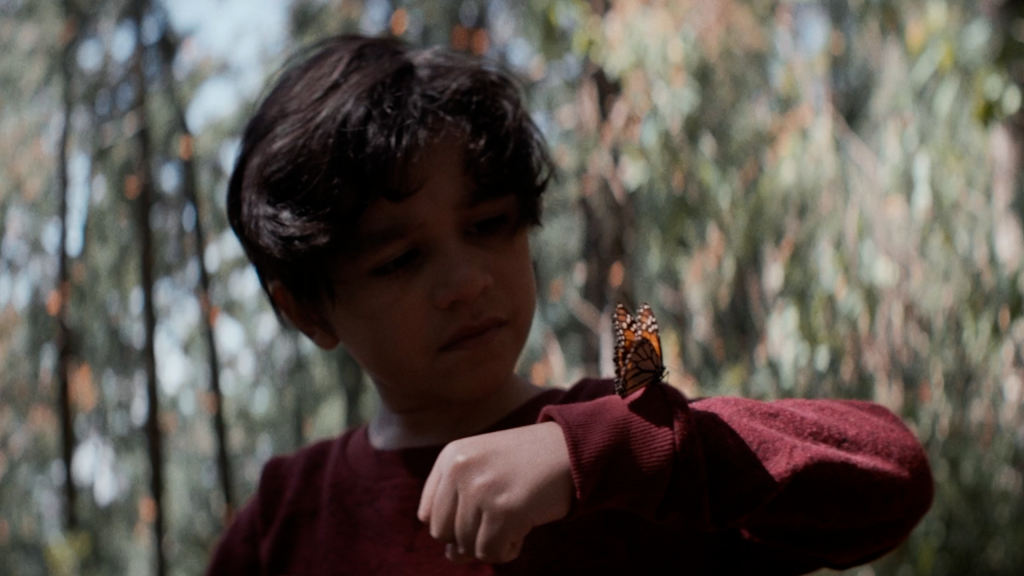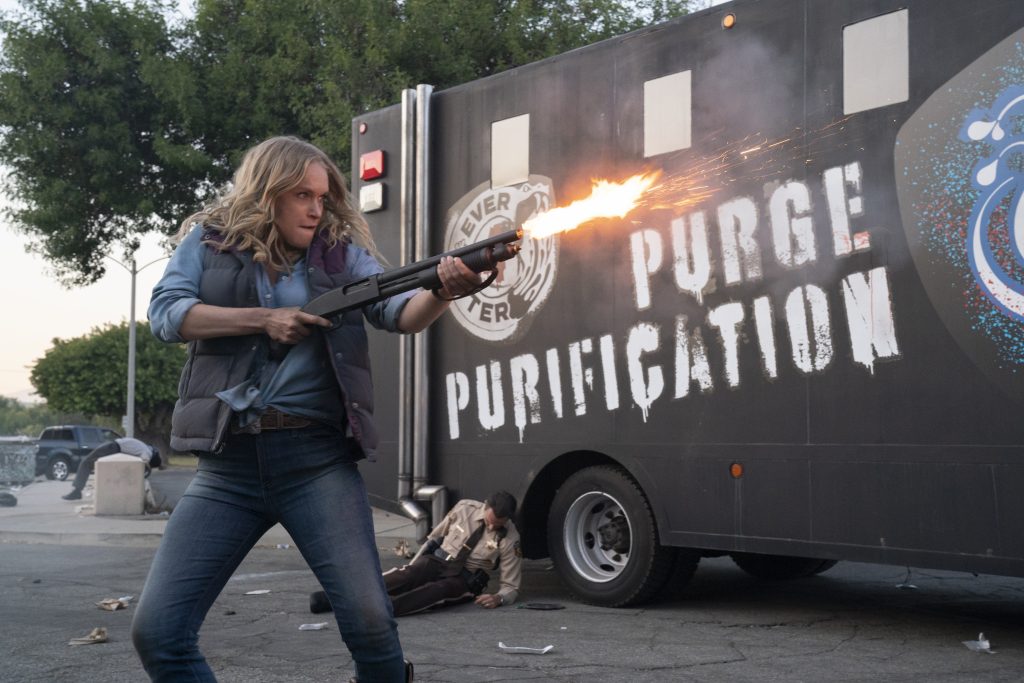December 31, 2021
by Carla Hay

Directed by Ryan Zaragoza
Some language in Spanish with subtitles
Culture Representation: Taking place in 1977 in California’s fictional Golden Valley, the horror film “Madres” features a predominantly Latino cast (with some white people) representing the working-class and middle-class.
Culture Clash: A Mexican immigrant and his pregnant American-born wife relocate from Los Angeles to rural Golden Valley and find themselves caught in a dangerous mystery over why women in the area have a history of pregnancy trauma and infertility.
Culture Audience: “Madres” will appeal primarily to people who are interested in watching movies that are based on real-life horror stories.

“Madres” is a “slow burn” horror movie that’s bound to make people uncomfortable. Even though there are supernatural elements in the story, it’s based on real-life traumatic incidents involving motherhood. The final 20 minutes of the movie make up for the aspects of the story that tend to get repetitive. The cast members of “Madres” also capably handle the material.
“Madres” is part of Blumhouse Television’s “Welcome to the Blumhouse” series partnership with Prime Video to showcase horror/thriller movies directed by women and people of color. Directed by Ryan Zaragoza and written by Marcella Ochoa and Mario Miscione, “Madres” at first appears to be a standard ghost story about a couple who have seemingly moved into a haunted house. But by the end of the movie, viewers will know that even though “Madres” takes place in 1977, the film makes an impactful statement about a shameful problem in society that still happens today.
In “Madres,” happily married couple Beto Obregon (played by Tenoch Huerta) and Diana Obregon (played by Ariana Guerra) are shown arriving in the rural, fictional town of Golden Valley in the northern part of California. Beto (who is 30 years old) and Diana (who’s about the same age or slightly younger than Beto) have moved to Golden Valley because Beto is a farm worker who has been offered a job to manage a farm. It’s his first managerial job, so the couple is excited about this job opportunity and increased salary, especially because Diana is pregnant with their first child.
Beto is an immigrant from Mexico who has been living in the United States for the past five years. He comes from a poor family, but he has the ambition and work ethic to want to achieve the American Dream. Diana was born in the United States and comes from a middle-class family who was originally from Mexico. Because Diana doesn’t speak Spanish and because she has a light skin tone, she could be mistaken for being a white American. It’s mentioned in the movie that Diana’s parents discouraged her from learning Spanish, which implies that her parents want to distance themselves from their Mexican roots.
“Madres” doesn’t just look at nationality issues. The movie also touches on conflicts that arise because of social class and colorism. In a phone conversation between Diana and her sister Veronica, viewers find out that Diana’s parents do not approve of her marriage to Beto, because he’s uneducated, he’s dark-skinned, and because the parents think Beto will be nothing but a poor farmer. Because of this disapproval, Diana has kept her distance from her parents, who seem to prefer Veronica as the “favored child.”
Diana has a journalism degree. Before she got pregnant, Diana worked as a journalist, but she got fired from her job for being pregnant, but she plans to go back to work when she can. In the meantime, during her pregnancy, Diana has been working on a book. It isn’t long after Diana and Beto are settled into their fixer-upper home that problems start happening.
Diana starts having nightmares, including one shown during the movie’s opening scene where Diana dreams that she has a newborn baby who disappears when the baby’s crib suddenly fills with dirt. Diana also starts to see and hear frightful things at various times of the day and night, such as shadowy figures, a boy with a bloody eye who’s hiding in a tree, and some egg yolk that looks like it starting to bleed.
“Madres” is definitely a “things that go bump in the night” movie, since a lot of scenes are about Diana witnessing something and starting to question her sanity. Sometimes, Beto goes to investigate things that Diana says that she’s seen, but he doesn’t find anything. In the meantime, Diana and Beto become increasingly worried about all of this stress will affect their unborn child.
At his new job, Beto’s supervisor is Tomas (played by Joseph Garcia), who seems to have a lot of confidence in Beto as a new hire. Beto earns the respect of his co-workers (who are all Hispanics/Latinos), but Diana has a harder time fitting into this farm community. At a company picnic, Diana feels like an outsider because she seems to be the only one who doesn’t know how to speak Spanish. And as a newcomer to the area, she also finds it difficult to adjust to living in a rural way of life in this tight-knit community
Even though Diana doesn’t speak Spanish fluently, she does know some words in Spanish. Therefore, Diana can still understand that she’s getting catty and jealous remarks from some of the other wives at this gathering. They think that Diana is too uppity for this clique because she’s light-skinned, college-educated, and never bothered to learn how to speak Spanish. A woman named Rosa (played by Leydi Morales), who is married to a farm worker named Rafael Ernesto (played by René Mena), seems to be the most jealous one in this group of farm worker wives.
During this picnic, Diana finds out that pregnancy and motherhood are touchy subjects in this community. Many of the women in the area have had miscarriages or can’t get pregnant. There are stories going around that maybe the women of Golden Valley are cursed.
Not long after moving to Golden Valley, Beto and Diana go to a gift shop, where they are greeted by Anita (played by Elpidia Carrillo), the shop owner. She offers to give a blessing to the Beto, Diana and their unborn child. Anita sells a lot of trinkets in shop, which looks like she caters to a lot of people who believe in superstitions. It should come as no surprise that Anita is called “The Witch Lady” by many of the locals.
One day, Anita shows up unannounced at Beto and Diana’s house and tries to give Diana a necklace for “protection.” Diana, who is put off by this unexpected visit, says that she’s not superstitious and she firmly refuses this gift. Anita insists that she gives this gift to all pregnant women in the town, but Diana still refuses to take the necklace.
The rest of “Madres” follows Diana’s pregnancy journey that goes from hopeful to harrowing. At one point, Diana ends up in a hospital maternity ward where someone named Nurse Carol (played by Kerry Cahill) is exactly like the type of nurse that you think she is when she interacts with Diana. Along the way, she tries to get to the bottom of the mystery of the house’s previous resident: A woman named Teresa Flores, who died in 1955, and left many of her possessions behind.
Why was the house unoccupied for 22 years before Beto and Diana moved there? Is Teresa possibly haunting the house? And if so, why? And does Anita know more than she’s telling Diana? All of those questions are answered in the movie.
“Madres” is not the type of horror movie that has a lot of action and gore. Anyone looking for that type of content throughout the film will probably be disappointed. The movie overall doesn’t do anything groundbreaking, in terms of jump scares or cinematography. Guerra’s performance is believable and carries the movie. Whether are not viewers like “Madres” largely depends on how much they can connect with Guerra’s portrayal of Diana.
And it takes a while for the movie to pick up its pace. The second half of “Madres” is better than the first half. By the end of “Madres,” it will become clear that the movie isn’t the usual ghost story. The biggest horror in the film doesn’t come from the supernatural but from human beings who commit heinous acts of evil.
Prime Video premiered “Madres” on October 8, 2021.




